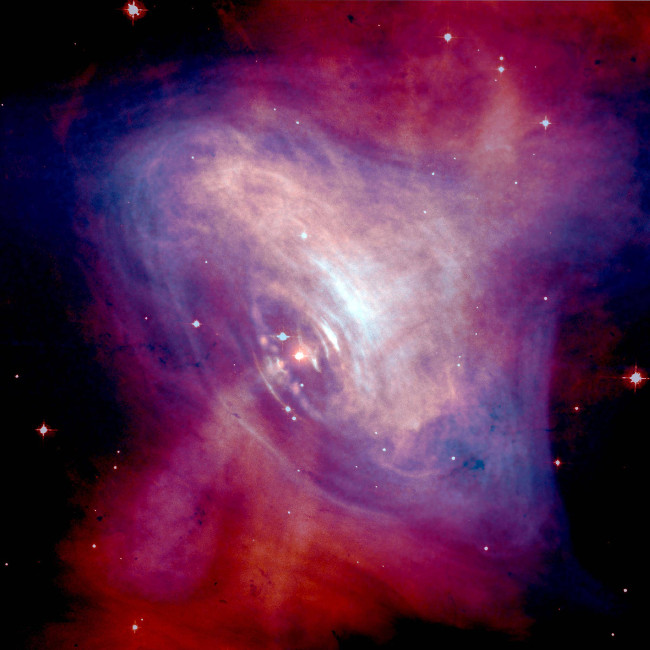What is pulsar (Plusar)?
The following article will bring about the most general overview of the pulsar star (or Plusar), invite you to consult.
What are pulse stars?
Pulsars (or pulsars) are very fast rotating neutron stars , which manifest as a source of radio waves, which are emitted at regular intervals. Radiation intensity varies with a regular cycle, which indicates the rotation of the star. Neutron stars rotate so quickly that centrifugal forces distort the star's radiation into a double cone, with the common peak at the center. This cone radiation rotates and only sweeps through a portion of space, so not all pulsars are visible, even when it is very close to Earth.

Synthetic optical / X-ray images of the Crab Nebula, with nearby gas being twisted up by pulsar's electromagnetic and radiation fields.
The process of studying pulsar stars
Pulse stars were first discovered in 1967 by Jocelyn Bell Burnell and Antony Hewish of the University of Cambridge through radio radiation, and later pulses of pulses emitting X-rays and gamma rays were discovered. Thanks to this success Antony Hewish was awarded the Nobel Prize in 1974. They obtained special radio waves, including uniform vibrations with a period of several thousand to several seconds. Their first assumption is that these waves come from extraterrestrial civilizations.
Today the scientific community is inclined to assume the hypothesis that explains the regularity of radio waves is due to being emitted from a star infected from very young and spinning very quickly. In order for a star to spin so quickly without being dissolved by centrifugal force, it must be very dense, which is the characteristic property of neutron stars.
Powerful radio transmissions weaken the pulsar's energy, causing its rotation speed to slow down. Among these are the pulsar of the Crab in the Crab Nebula, the rotation speed being reduced by one tenth of a million annually. In binary star systems, pulsars absorb the material from the companion star to maintain this energy.
Classification of pulse stars

Vela pulse star.
So far there are three known types of pulses, classified according to the source of radiated energy:
- Pulse stars have variable energy, this energy loss generates radio waves.
- Why pulses accumulate energy (including most but not all pulses emit X-rays), when the gravitational field's energy increases simultaneously with matter that creates the energy source (producing X-rays that produce on Earth can be received).
- Magnetic stars, where magnetic fields are weakened, generate radio waves.
Although all three types of stars are neutron stars, they have relatively different states and physical properties. However, they are also related. For example, pulsar pulses emitting X-rays are pulses of energy that change in age and lose almost all energy, and are only realized when the companion stars expand and move matter towards the pulsar. . This further development process will transfer enough angular momentum to pulsed pulses to "recycle" the pulsed star whose energy changes a millisecond.
- What is a Neutron Star?
- What is a white dwarf?
- Roscosmos announces the sound of neutron stars
- Close up of a star's death
- The woman received a reward for discovering the hidden planet, but another received the NOBEL award for her discovery
- 'Weigh' the planets
- Strange star flashes like a beacon
- Cleaning buildings with ... ice water
- The map can take aliens to invade Earth
- Detecting unprecedented neutron stars, challenging the physical limit
- For the first time, a star has been discovered in a star
- Unknown things about the North Star
- Found a new type of black hole, hidden in dense star clusters
- Firefighters on board warships
 Van Allen's belt and evidence that the Apollo 11 mission to the Moon was myth
Van Allen's belt and evidence that the Apollo 11 mission to the Moon was myth The levels of civilization in the universe (Kardashev scale)
The levels of civilization in the universe (Kardashev scale) Today Mars, the sun and the Earth are aligned
Today Mars, the sun and the Earth are aligned The Amazon owner announced a secret plan to build a space base for thousands of people
The Amazon owner announced a secret plan to build a space base for thousands of people